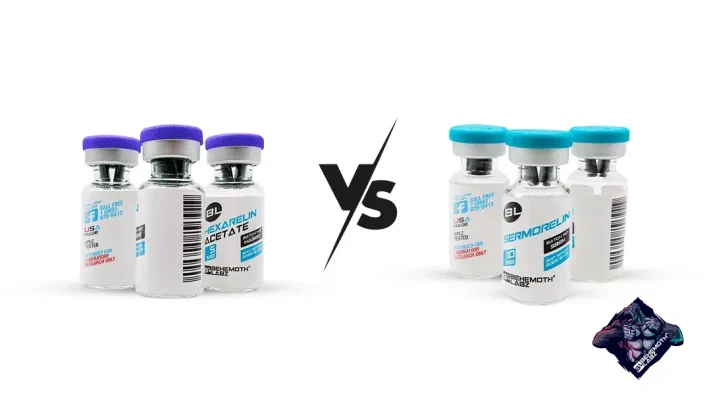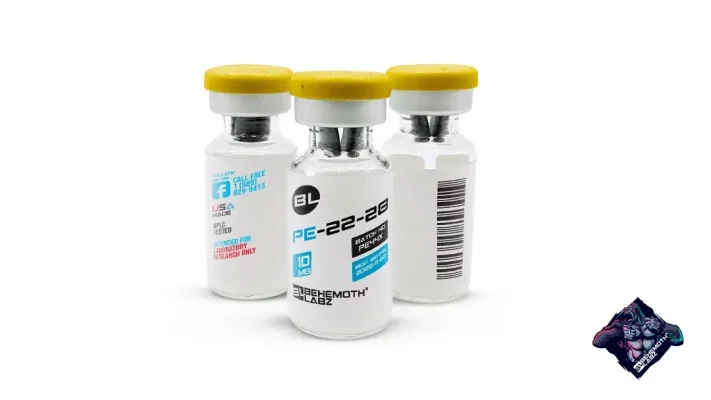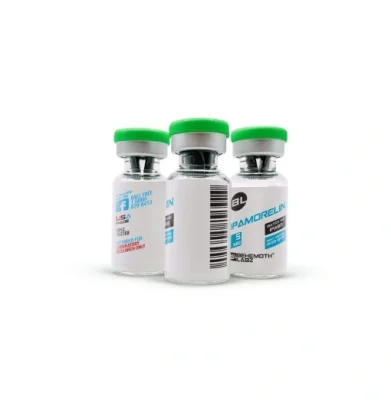Peptides
Tesamorelin vs Ipamorelin: A Comprehensive Overview
Are you curious about Tesamorelin vs Ipamorelin? These peptides are often compared and contrasted due to their potential benefits in the research field.
In preclinical studies, Ipamorelin has been associated with greater effects on lean tissue development, while Tesamorelin appears to be more effective in modulating adipose tissue reduction in research models. To understand the differences in more detail, read on to learn everything you need to know about Tesamorelin and Ipamorelin.
What is Tesamorelin?
Tesamorelin is a synthetic peptide and growth hormone-releasing hormone (GHRH) analog. Canadian technology company Teratechnogies created it in the 1990s. As a growth hormone stimulator, it has shown the potential to reduce excess visceral adipose tissue (VAT) in HIV-positive subjects with lipodystrophy. In research models, Tesamorelin may influence physiological parameters related to fat distribution and has been shown to reduce visceral adiposity. However, its effects on insulin sensitivity remain under investigation.
What is Ipamorelin?
Like Tesamorelin, it is a synthetic peptide. However, Ipamorelin is a selective ghrelin mimetic that stimulates the release of GH by binding to ghrelin receptors (GHS-R1a) in the pituitary and hypothalamus of subjects. With a five amino acid chain, Ipamorelin is much simpler than Tesamorelin.
Tesamorelin vs Ipamorelin: Side-by-Side Comparison
Although both peptides have been shown to boost the growth hormone, they are still different in their mechanism of action, benefits, and side effects observed in test models. Below is a comprehensive comparison between Ipamorelin and Tesamorelin.
1. Mechanism of Action
Due to different receptor interactions, Tesamorelin and Ipamorelin have distinct mechanisms of action. On the one hand, Tesamorelin binds to the GHRH receptor in the anterior pituitary to trigger the natural GH-releasing pathways.
Conversely, Ipamorelin mimics ghrelin and binds to the growth hormone secretagogue receptor (GHS-R1a). This triggers a pulsatile GH release without affecting cortisol or prolactin levels. Research studies have shown that it also suppresses somatostatin, a hormone that inhibits the production of GH. This action may enhance the body’s natural ability to release growth hormones.
2. Benefits
With growth hormone-releasing capabilities, Ipamorelin and Tesamorelin have shown several but distant benefits in research investigations. Researchers conducted a thorough research on mice and rats and have found the following benefits: [1]
- Somatic Tissue Accretion: In controlled laboratory studies, Ipamorelin has been observed to promote somatic tissue accretion in rodent models. This effect is associated with its capacity to stimulate the endogenous release of growth hormone (GH), which may activate anabolic pathways leading to increased protein synthesis and tissue growth. [1]
- Adipose Tissue Modulation: Ipamorelin has also demonstrated potential in influencing adipose tissue metabolism. Increased GH levels induced by this compound may enhance lipolytic activity and metabolic rate, thereby contributing to the reduction of stored lipid deposits in test models. [2]
- Bioenergetic Efficiency: Research findings suggest that Ipamorelin may augment metabolic rate, resulting in increased utilization of lipid substrates as an energy source. This shift in substrate preference may support improved bioenergetic efficiency in experimental organisms. [3]
- Modulation of Sleep Architecture: Experimental investigations indicate that Ipamorelin may affect neurophysiological parameters related to sleep regulation. Specifically, the compound has been associated with increased duration or quality of slow-wave (stage 4) and rapid eye movement (REM) sleep phases in research subjects. [3]
In contrast, Tesamorelin has shown the following benefits in research investigations.
- Visceral Adipose Tissue Reduction: Tesamorelin has been identified as a potent compound for modulating lipid distribution in research models. It may elicit a metabolic response that facilitates the reduction of visceral adipose tissue (VAT), particularly in models exhibiting central lipid accumulation. Preclinical and clinical data have shown significant decreases in VAT, including in HIV-related lipodystrophy models. [1]
- Somatic Tissue Development: Tesamorelin has demonstrated potential to support somatic tissue accretion, though typically at a lower rate compared to Ipamorelin. This effect may be mediated through the stimulation of muscle fiber protein synthesis, contributing to the development of lean tissue in research subjects. [2]
- Physiological Endurance: Increased lean tissue mass associated with Tesamorelin exposure may correlate with enhanced endurance capacity in experimental organisms. Myofibrillar hypertrophy observed in studies suggests a potential link between Tesamorelin administration and improved performance-related parameters. [2]
- Lipid Metabolism Regulation: Tesamorelin has also shown potential for modulating lipid metabolic profiles in test models. Documented effects include a reduction in circulating triglyceride concentrations and a favorable shift in the cholesterol-to-high-density lipoprotein (HDL) ratio, indicating improved lipid handling under research conditions. [3]
3. Results
Research studies have shown that Ipamorelin increases growth hormone levels more than Tesamorelin. It may increase GH levels by 3 to 13-fold above baseline levels in research subjects. Similarly, Ipamorelin has demonstrated greater efficacy in promoting lean tissue accretion. In contrast, Tesamorelin is generally regarded as more effective in modulating adipose tissue reduction.
4. Side Effects
While both peptides have demonstrated various benefits, they may also be associated with certain adverse effects, typically observed at lower frequencies. In research models, Tesamorelin may induce localized reactions at the injection site, myalgia, edema, and alterations in glucose metabolism. Ipamorelin, in contrast, may be linked to cephalalgia, gastrointestinal discomfort, and injection site responses. It is important to note that the manifestation and severity of these effects may vary depending on dosage and duration of administration in research subjects.
Which Peptide is Better?
The best choice between these two peptides depends on research goals and objectives. For studies focusing on adipose tissue reduction, Tesamorelin may be the preferred option. However, for investigations centered on lean tissue accretion, Ipamorelin has demonstrated more pronounced efficacy, making it a suitable choice for research related to muscle development.
Conclusion
The comparison of Tesamorelin and Ipamorelin has garnered considerable interest within the research community due to their potential effects on adipose tissue reduction and lean tissue development in experimental models. As growth hormone secretagogues, both compounds may elicit a range of biological responses in controlled studies. However, they differ in terms of their mechanisms of action, observed benefits, and associated adverse effects in research models.
Frequently Asked Questions
Which peptide can increase the insulin-like growth factor-1 (IGF-1)?
Both Tesamorelin and Ipamorelin may increase the insulin-like growth factor-1 (IGF-1) by stimulating growth hormones that, in turn, act on the liver and other cells to release IGF-1 in research models.
Where to buy Tesamorelin and Ipamorelin online?
Are you interested in studying Tesamorelin and Ipamorelin? Consider buying them online from BehemothLabz. It ensures high-quality research peptides at affordable prices. Besides quality, its products also provide optimal and effective results in research investigations.
Which peptide is legal and safe?
Generally, Tesamorelin and Ipamorelin are considered safe and legal for research studies. Tesamorelin is FDA-approved for reducing visceral fat in HIV-infected subjects. However, these are not approved for human consumption.
References
- Grunfeld, Carl, Argyris Dritselis, and Peter Kirkpatrick. “Tesamorelin.” Nature Reviews Drug Discovery 10.2 (2011): 95-97.
- Stanley, Takara L., et al.. “Effects of tesamorelin on non-alcoholic fatty liver disease in HIV: a randomized, double-blind, multicentre trial.” The Lancet HIV 6.12 (2019): e821- e830.
- Raun, Kirsten, et al. “Ipamorelin, the first selective growth hormone secretagogue.” European journal of endocrinology 139.5 (1998): 552-561.












